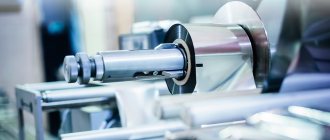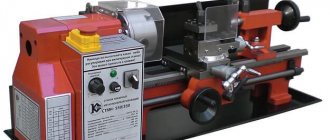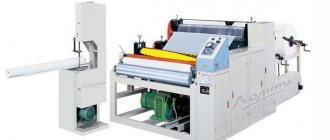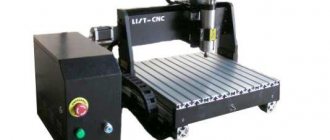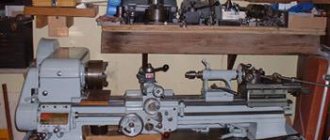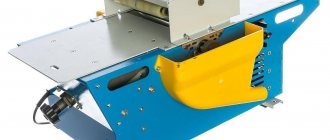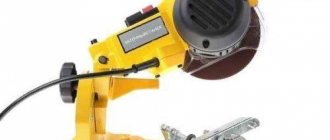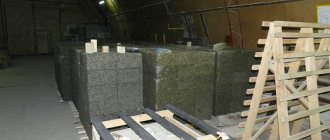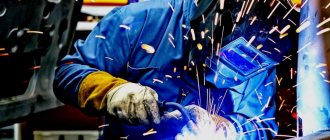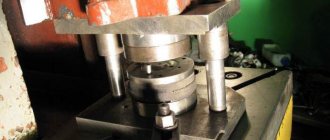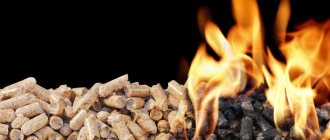In production conditions, various metalworking machines are used. They are used for the manufacture and processing of metal blanks. There are universal and specialized models. To understand metal processing equipment, you need to know the types and operating principles of metalworking machines.
Metalworking machine
Types of metalworking machines
Equipment used in the manufacturing and metalworking industries comes in many varieties. The type of machine depends on its design, control method and equipment. Based on functionality, industrial equipment can be divided into two large groups:
- Specialized - machines that perform only one specific option. Most often, they cannot be reconfigured.
- Multifunctional (universal) - combined machines. Can perform multiple production processes.
Classification of metal processing equipment by type:
- Cutting machines are machines used for cutting metal sheets and cutting workpieces. These include band saws and circular machines.
- Milling - devices with a working surface on which a cutter is fixed. Torque from the spindle is transmitted to it. As the cutter rotates, it removes a layer of metal from the workpiece. Used for machining ends, drilling holes and other operations.
Industrial machines are equipped with a CNC system. With their help, you can set a specific program according to which the key components of the machine will operate without further human intervention. However, only experienced operators can be trusted to configure the program.
A separate group includes equipment for cutting external and internal threads. You can also distinguish between home and industrial devices. The former are intended for small workshops and garages, the latter for mass production of certain parts. The remaining groups of metalworking equipment will be described below.
Machinery equipment repair
Industrial machines are operated in fairly harsh conditions, so they periodically break down and require repair. Repairing machine equipment is quite a serious matter and therefore it must be carried out by qualified specialists.
There are two main types of repairs:
- Maintenance. This is the simplest option for repair work, during which breakdowns of individual machine elements can be eliminated. Typically, routine repairs do not require a lot of time and are carried out directly at the installation site of the equipment.
- Major renovation. Such repairs can also be carried out at the installation site, but more often this requires a specialized workshop. During a major overhaul, the equipment is completely disassembled; this is necessary in order to accurately diagnose the problem. The main objective of such repair work is to restore the original capabilities of the equipment.
Another type of maintenance relates to machine modernization. This service has become widespread recently. It allows you to make the equipment more versatile and adds new functions to it.
Advanced Metalworking Techniques
Industrial equipment is constantly being improved. What features are being improved:
- Performance. This is an important factor that affects the payback of the equipment and the profit that can be obtained when working on the machine. Productivity increases as the speed of the mechanisms increases.
- Accuracy. To reduce the number of defects, equipment manufacturers are working on the accuracy of operating mechanisms.
- Durability and wear resistance.
The most common operation in which metalworking machines are used is cutting.
Gas metal cutting
Gas cutting equipment has been used for a long time. It is fully automated and requires minimal effort to operate. The CNC system makes it possible to perform even cuts on metal workpieces, which was problematic due to the presence of the human factor.
Advantages of gas cutting:
- high speed and productivity;
- cheap equipment.
Minuses:
- heat shrinkage of metal after completion of work;
- possible errors in accuracy.
Gas equipment is installed in large enterprises and private workshops.
Gas metal cutting
Plasma cutting
The principle of operation of plasma devices is that the cutting of a workpiece or sheet occurs using a plasma jet. Such metalworking machines have high cutting accuracy and productivity.
Laser processing
Laser machines for metal processing are popular in private workshops and in production. The laser head moves along guides and cuts the workpieces into marked parts. Engraving can be done with a laser beam. Such machines have high precision. They are used to process homogeneous metals and soft alloys.
Grinding
Grinding machines are designed for finishing metal surfaces. Depending on the required removal thickness, the fraction of abrasive wheels or sanding belts is selected. More than one abrasive wheel or belt can be attached to one machine.
Turning
The turning group includes designs that are used to create parts of complex shapes. The working part is a rotating spindle into which the workpiece is fixed. To process a workpiece, it is necessary to secure certain cutters in a support and bring parts to them. Sharp edges cut off the metal layer under the influence of rotation. Can be used for drilling, threading inside and outside workpieces, countersinking, boring holes.
Drilling
Drilling machines are devices with a fixed frame on which one or more spindles are fixed in a vertical position. They can be used for drilling, countersinking, and internal threading. Taps can be used to bore holes in workpieces.
Drilling machine
Waterjet and electroerosive
This is equipment used for cutting metal sheets of any thickness. The principle of operation is that the metal is cut using a thin water jet, which acts on it under high pressure. The disadvantage of this method is low speed. However, it is compensated by high cutting precision.
Gantry metal gas cutting machines
The equipment is intended for production. This is due to the ability to place large metal sheets on the working surface. Their sizes can reach 3×12 meters. The pros and cons of such machines are exactly the same as those of conventional gas cutting.
Main components and mechanisms of metal-cutting machines
Let's look at the main components and mechanisms of metal-cutting machines using the example of a lathe. A general view of the lathe is shown in Figure 7.
Figure 7 – General view of the machine
The main components of the machine are shown in Figure 8.
Figure 8 – Main components of the machine
The machine bed is most often made of cast iron and is the basis for attachments, shown in Figure 9.
Figure 9 – Machine bed
The required relative position of machine components and the possibility of relative movement of the tool and workpiece are provided by guides (Figure 10).
Figure 10 – Adjusting elements with a longitudinal (a) and transverse (b) wedge, with a clamping (c) and overhead fitting (d) strip
According to their purpose and design, guides can be classified according to the following criteria:
- by type of movement: guides of the main movement (for example, a table-bed of a longitudinal planing machine); feed movement guides; directing rearrangements of mating and auxiliary parts and assemblies that are stationary during processing;
- along the trajectory of movement: guides of rectilinear and circular movement;
- in the direction of the node’s movement trajectory in space: horizontal, vertical and inclined;
- by geometric shape: prismatic, flat, cylindrical, conical (for circular motion only) and their combinations.
The most widespread in machine tools are sliding and rolling guides. Sliding guides (Figure 11) are usually made of gray cast iron. Cast iron is used in cases where the guides are made as one piece with the frame or moving unit.
Figure 11 – Basic cross-sectional shapes of sliding guides: a – flat; b – prismatic; c – dovetail-shaped; g – cylindrical
Based on the type of sliding friction, the following guides are distinguished:
- hydrostatic – guides of the main movement and feed; in these guides, the lubricating layer is created by supplying oil under high pressure into special pockets of the required size;
- with mixed lubrication - most feed movement guides;
- with boundary lubrication – feed guides operating at very low sliding speeds;
- with air lubrication - aerostatic.
Rolling guides are widely used in machine tools using balls and rollers as intermediate rolling bodies. The advantage of rolling guides is low friction, independent of the speed of movement. Rolling guides provide high accuracy of movements, uniformity of slow movements, they are more durable than sliding guides. Like sliding guides, rolling guides can be closed or open.
The headstock is most often called the spindle headstock (Figure 12), since its main unit is the spindle (Figure 13). The spindle holds chucks, various mandrels into which the workpieces are installed and secured. In addition, the gearbox, pulley and bearings are located here.
Figure 12 – Headstock
A spindle is the shaft of a metal-cutting machine that transmits rotation to the tool or workpiece fixed in it.
The structural shape of the spindle depends on the method of fastening the clamping fixture or tool on it, the fit of the drive elements and the types of supports used. Spindles are made hollow for the passage of the rod, as well as to reduce its weight.
Rolling and sliding bearings are used as supports for machine tool spindles. Since high precision is required from spindles, rolling bearings must be of high accuracy classes. The front support uses more precise bearings than the rear one. Spindles and bearings must be reliably protected from contamination and cutting out of lubricant; for this purpose, various seals are used.
Figure 13 – Spindle
The tailstock consists of a bottom plate and a quill holder. A tool or fixture can be installed in the tailstock (Figure 14). Most often, the tailstock is used when processing long parts, pressing the end of the part with a cone. The guides along which the tailstock moves must be clean and lubricated.
Figure 14 – Tailstock
A support is a machine unit in which a cutting tool is installed and which allows it to be moved in the longitudinal, transverse and oblique directions. The carriage provides longitudinal movement along the slide, the upper part of the support provides transverse movement. Tool holders are installed in the upper part of the caliper (Figure 15).
Figure 15 – Machine support
Apron. To ensure the longitudinal and transverse movement of the caliper, gears located in the apron have been developed (Figure 16). With the help of these gears, the rotational movement of the lead screw is converted into the translational movement of the caliper.
Figure 16 – Machine apron: 1 – manual feed flywheel, 2 – roller, 3 – button for turning on mechanical feed from the roller, 4 – gear, 5 – rack and pinion, 6 – gear, 7 – rack, 8 – gear wheel, 9 – worm, 10 – split nut, 11 – lead screw, 12 – handle for turning on the mechanical feed from the lead screw when cutting threads, 13 – handle for turning on the mechanical feed
All components and mechanisms of the equipment must be kept in good condition, that is, all rubbing parts must be clean and lubricated with appropriate lubricant. This is the task of the equipment operation service, but maintenance personnel must also monitor the condition of the equipment, for example, monitor the timely replacement of filters, cutting fluid, and even, depending on the operating hours, monitor the timely replacement of oil in the hydraulic system of the machine.
Automation levels
According to the level of automation, metalworking machines are divided into the following types:
- Manual equipment. All mechanisms are controlled by humans.
- Semi-automatic devices. In such machines, half of the mechanisms operate automatically, while the other requires adjustment and control by a master.
- Automatic machines. Equipment that can work independently. The operator should initially set the algorithm for the moving mechanisms.
- CNC machines. Fully automated designs that require a program to operate. In accordance with it, the mechanisms and working parts of the machine will move.
The most popular are machines equipped with CNC systems. Numerical control consists of several key elements:
- Console - through it the operator sets the program according to which the production process will take place. In addition to automatic operation, the console has a remote control for manual control.
- A controller is a mechanism that calculates future movements of moving mechanisms and machine elements. The controller is a powerful microprocessor that controls all mechanisms.
So that the operator can see what program he is specifying, there is a screen in the CNC system. It displays algorithms, dimensions of the workpiece being processed, possible errors and inaccuracies.
Automation of metalworking
Operation and maintenance of machine tools
Machine tools are quite complex mechanical and technical systems, the operation of which requires certain knowledge.
Manufacturers of machine tools accompany each product with special documents, which contain data that allows for proper control and operation of specific equipment.
These documents provide information about the machine, its controls, lubrication schemes and the location of certain components and assemblies. Such accompanying documents also indicate the maintenance of the machine, its repair and safety precautions.
The machine equipment operation system must operate in such a way as to minimize downtime and ensure normal operation.
For smooth operation it is necessary:
- timely supply of machines with the necessary workpieces, parts, lubricants, tools;
- carrying out operations for loading workpieces, cleaning, removing chips, filling coolant and lubricating parts;
- timely detection of breakdowns and malfunctions with their subsequent elimination;
- replacement or restoration of failed structural elements and assembly units.
Machine equipment must undergo scheduled maintenance. Since unscheduled maintenance increases the failure rate of equipment, leads to a decrease in its durability, and, accordingly, increases the costs of the enterprise.
Design
The design of metalworking machines is a connection of several key parts and mechanisms. Main operating elements of the equipment:
- Cast frame. Acts as a base. The rest of the machine parts are attached to it. Must dampen vibrations arising from engine operation.
- Control system. It is a remote control for setting up moving mechanisms.
- Spindle with chuck for equipment.
- Work surface with clamps for workpieces.
In addition to key components, guides, protective shields, calipers, movable heads and other additional elements are distinguished. We must not forget about the cooling systems. They can be air or liquid. Used on industrial equipment under heavy loads. On CNC devices, additional electric motors are installed, which are responsible for the mobility of the working part of the equipment along the guides.
There are different types of metalworking machines on sale. They differ in design, functionality, purpose, dimensions, and control systems. When choosing a production machine, these features should be taken into account. Wear-resistant designs are chosen for mass production. Less productive equipment is suitable for a garage or workshop.
Classification of machines according to possible processing material
All production machines are divided according to their technical characteristics, based on the material of the workpieces that they will process. Thus, metal and wood are considered the main materials with which machine tools work. Machines with weaker power ratings are suitable for working with wooden workpieces. But, on the other hand, woodworking machines should be provided with more flexible settings for operations. As for metalworking machines, they require higher power and a reliable element base. The most popular are turning, milling and drilling machines.
